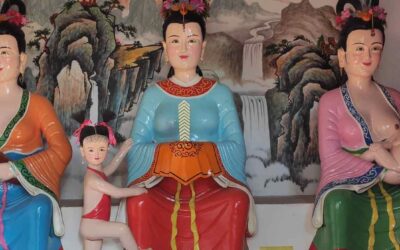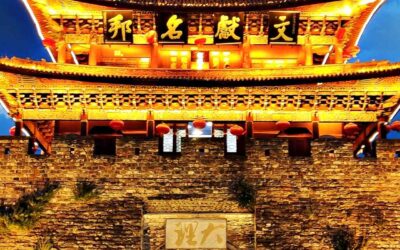Deciphering the culture of the fertility cults (生殖崇拜的文化解读 Shengzhi chongbai de wenhua jiedu). Liao Mingjun. Guangxi Peoples Press. Nanning, 2006
This book is a study of the fertility cults among the Chinese nationalities. Introducing the reader the different manifestations that these cults take shape in the myths, rituals and taboos of the Han Chinese and the national minorities, it is an attempt to compile a complete overview of the fertility cults in China.
After some general remarks about the fertility cults the author depicts some instances that can validate the relationship between different objects, natural phenomena, animal and plants and their fertility power. So we know about the stone cults, earth cults, and water, thunder and fire cults. About the tree, bamboo, flower, gourd and water melon cults and their relation with the human fertility; about the fish, frog, snake, birds and eggs in the animal realm and about the genital cults in the human sphere.
Choosing to study the fertility cults of so many objects and animals, illustrated with more than 100 pictures and maybe twice the number of complete myths from different minorities, the author cannot provide more than a somewhat superficial analysis of some myths and ritual extracted from different minorities and epochs that sometimes are far from convincing.
Nevertheless this book make a rather comprehensive introduction to this subject, emphasizing the unity of some cults, rituals and mythic motives through times and cultures and stressing the need to study the culture of the Chinese minorities beyond the strict line that imposes an official ethnic classification so many times despised by the scholars.
The book also throws light to hidden aspects of Zhuang culture as the author, himself a Zhuang nationality researcher; usually compare myths and rituals from other peoples and times with those of the different branches of the Zhuang.
The book contains a vast amount of information. Among the many interesting themes treated in its pages the readers can find:
Reader mast we aware that I publish here the notes written to myself. I read this book when I was looking for information about goddesses and matriarchy in China, so most of the notes are references to goddesses, matriarchy, women symbolism, etc.
32-33- Poem to the land Naxi
35- Kazakh legend of the creator goddess.
41-43- Wa legend of creation. Another version of the already translated one.
46- Wa – blood to the earth. Three types of blood offerings in ancient China.
46-7. The Zhuang go from offerings human to offering cows.
47- generative power of woman and mother earth associated.
49- Lobha prayer
67- branches of the Gelao
68- rite of the Lhoba Bokaer
70- Dawoer Goddess (women breastfeeding from the back)
81- prostitutes asking for rain.
82- Dawoer pours water to end drought
85_ Also among the Tujia of Sichuan
87_ Li myth of the first woman hatching from a snake egg. And another Li myth on pages 88-9.
100- Song to the Goddess of Flowers.
102-3. Jingpo ceremony to the thunder.
106- Shui Goddess of Thunder
109- Zhuang Ceremony for thunder up to 119. With reference to engravings of people naked and copulating (117) to reinforce the germinative power of thunder.
124- Ewenki and grandmother giving children.
131- Dong sexual ceremony
141- Elunchun goddess of fire, and other goddesses of fire. Kazak goddess of fire.
142- Mongols, Ewenki and fire.
(It should be noted that fire is as important to these peoples as agriculture is to the Dai) and others related to fire and women.
- Abukaenduli means Goddess of the Sky.
157- The hundred leaves that give origin the humanity among the Deang, are not necessarily tea leaves. Before there is a woman who is born of the God of Heaven and Mother Earth.
158- Miqie, Yi branch.
168- Amadu Festival of the Ani
178- Myth Hani interesting.
182- Lhoba funerals
188- Sex-shaped leaves, symbolize it. As the willow among the Manchu or the bamboo in other peoples.
188-9. Maegus. Tujia phallic cult.
195- Monkey originates the Yi.
Origin of the Yi branches.
200- ceremony for the ancestors YI – Nixixi
202- Buyi Child SURVIVING IN BAMBOO BASKET AND THE RITE OF ASKING FOR CHILDREN
203- Pumi, Miao and Jino ask for children from bamboo
207- Among the Yao and Zhuang the bamboo protects the children.
210- Bamboo’s funerary role among the Yi and Gelao.
213- The Aini with three white stones make the bamboo hearth- and the woman who cuts the bamboo for the dead.
215 – Emperor and flower.
217- Dai Creation of the world from lotuses and stones.
219-20- Another Zhuang myth of Miliujia.
230-The Yao ask for children from the Lady of Flowers, with songs to her included.
232- Lady of the Flowers Zhuang.
233- In other Zhuang places she is called Goddess of the Door or of the Bed.
234- For the Yao the children come from the garden of flowers by means of a bridge.
235- The Buyi believe in three worlds, the unborn are in the world of the flowers, and a bridge must be made for them to reach the world of the living.
235 to 239- The Tujia ask for flowers when they want children, and the two poems that are used.
240- The Maonan and their Goddess Flower Queen.
241- Chasan Yao – The Goddess of Flowers and the rituals of the child’s growth.
244- We are Flowers, and after dying, we become flowers again, and relationship with Miliujia.
245- Lady of Flowers among the Zhuang gives and takes away life. She sends flowers into the world, people are born, and she collects them for her garden, when they die. She is actually Miliujia, as she tells in the following pages. This part is the basis that shows Miliujia -Lady of the Flowers as the most important goddess among the Zhuang.
248-52. The goddess of Flowers among the Zhuang is a Goddess of fertility, she is actually Miliujia.
252- The Buyi and the Maonan and their Flower Goddesses, discussing in the following pages their identification with Guanyin.
258- The Li come out of the gourd.
260- Achang and Deang coming out of the gourd and Dai (62), Jino (63) and Yi (69).
270- Rna Ximalu of the Hani and the myth that originates them.
273 to 277- gourd and two brothers
280- wind symbolizes copulating.
284- among the Yao
288- Myth of the Bai where Guanyin gives them the grain.
286- goddess gives the people fertility pills.
295-7. Jiamu Ceremony of the Bai.
301- Yi poem which tells that after death people return to the gourd.
304- Bai myth in which the first two people are born from two watermelons.
313-4. Dai story of the Garden of Eden and snake that gives them the fruit of death. Another in 315
319- Xiwangmu as a goddess of death.
323- Tujia song of Nuwa, peaches of life and creator myth.
329- Lotus and fish in Miao weaving.
- Manchu water goddess and more in 338
332-3- Hani golden mermaid
336.- Protector goddesses of the Chasan Yao
341-6 – Two Pumi myths with frog
347 to 351- the end of cannibalism Zhuang
354- frog and moon eclipse origin
355- March 3rd Zhuang marriage and other branch Zhuang tales
358-66- Details of the Zhuang Frog Girl Festival
369- cannibalism, frog and bronze drum of the Zhuang.
377- discussion of Fuxi, nuwa, Gong gong and other gods with human head and snake body.
382- Snake and Nuzu flood.
385- A version of the Zhuang flood in which a wounded dragon falls from the sky and people eat it, except for one family, whose children are the ones saved from the flood. It is related to the myth where Leigong is eaten and may be related to not respecting the control of the waters.
396- ewenki tells that the snake gives medicine for sick mother.
410- kemu tale bird.
415- among buriatos the first shaman is son of an eagle and a woman.
416 to 20- zhuang bird tales.
421- tujia and wedding by crying.
425_ Lobha bengru and chicken
426- Obha Bokaer
432- Umai ewenki
434-5- Yi ancestors’ calling prayer
441- Funeral of the Baige branch of the Gelao living in Malipo, complete with text.
459- tale of the Lobha Aka
465- butterfly breast of the Miao.
470- Lobha myth
490- Lobha branch Miguba
505 to 6. Goddess Gamiga of the Zhuang and relationship with Miliujia.
509- Ancient cave burials may reinforce her symbolism with the uterus, where a rebirth takes place.
510- Myth, burial caves and goddess.
511_ Jung says that the cave is the uterus of the mother earth.
Dutch scholar speaks of the Taoist cult of the woman.
512- some dyed red at the door as in Pinguo xian
That is why it is possible that burying in caves, as the Yue and Liao did, could be a sign of matriarchy. In some cases they place them naked.
513- The Buriat Mongols call caves «mother’s belly» and venerate them.
514- the earth as mother
517_ Burials in the fetal position among the Zhuang and among the Bunong.
Burial in this way is to take him into the womb of mother earth in the hope that he will come out again.
It was already done in Bampo, in jars.
522-3 Discussion and drawings of goddesses in Hongshan.
524- Shibaoshan stone worshipped by Bai women, and the Moso and Pumi worship cave of Badinglamu, the goddess.
525- the 9 mother goddesses of the Dongyue miao
Xilangmama of the Xibe
526- phallic cults
529-30- more about Zhepama and Buluotou
532- phallic cults are an important part of the reproductive cults of the peoples of China.
533- Lobha hangs phallic symbol at home and explanation of the ceremony.
534 and following – phallic trunk of the Memba and possible resemblance with the drum wa.
537- rock exuding water as phallic symbol Moso
538 – phallic symbol in China and book of songs.
539- Phallic ceremony of the Miguba branch of the Lobha.
540- also among Apatani
542- zu is phallus in ancient characters.
543- For the Dai the phallus of Bayama protects them from the demons.
548- Dong and its phallic symbols in funeral.
550- Feast March 3 among the Dong, also generative.
551- Nuzu frighten the demons with a phallus, also the Maonan, Zhuang and Deang.
554- phallic embroideries of Li women, Ji branch.
555- phallic paintings in xinjiang
556- in Guangxi, river Zuojian
557_ more about the Maokus of the Tujia.
559_ Phallic dance to ask for rain among the Dai of Mengman and more symbols among them.
564- kawakafu creates the Dulong.
565- Chinese erotic dances.
Frog symbolizes the whole among the Naxi.
566_ more about Zhepama and Zhemima.
566- yao red (fem) and white (masc) house and ceremony where they are symbolically mated.
568_ Dai snake, paradise and fruit.
575 to 7 – Miao ceremonies
582_ human sacrifice after ritual copulation
Li resembles it
583- in Pangu ceremony of the Yao
586- Qiang rain ritual
[Cite]
Last posts
Sexual aspects of Gu venom
Gu illness resulted from a contamination by gu poison, which a recent analyst has characterized as “an alien evil spirit which entered [the] body and developed into worms or some similar animal that gnawed away at the intestines or genitalia.” This poison was thought...
Sunset in Dali
No Words Fuxing Rd from the South Gate. Dali, Yunnan.Corner in Fuxing Rd, Dali, Yunnan.Night market at the south of the South Gate. Dali. YunnanLast posts
The five secret temples of the lamas in Lijiang
The five secret temples of the lamas in Lijiang Religions of Lijiang Although the city of Lijiang is known primarily for the Dongba religion practiced by the traditional shamans of the Naxi, also called Dongba, who with their rituals administered the religious and...







